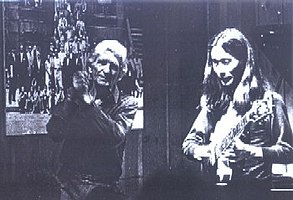Gil Evans
| Gil Evans | |
|---|---|

Evans (left) with guitarist Ryo Kawasaki at Sweet Basil, New York City, 1982
|
|
| Background information | |
| Birth name | Ian Ernest Gilmore Green |
| Born |
13 May 1912 Toronto, Ontario, Canada |
| Died | 20 March 1988 (aged 75) Cuernavaca, Mexico |
| Genres | Jazz, third stream, cool jazz, modal jazz, jazz fusion, free jazz |
| Occupation(s) | Musician, composer, arranger, bandleader |
| Instruments | Piano |
| Years active | 1933–88 |
| Labels | Prestige, World Pacific, Impulse!, Verve, Columbia |
| Associated acts | Miles Davis, Gerry Mulligan, Ryo Kawasaki, Kenny Burrell |
| Website | www |
Ian Ernest Gilmore "Gil" Evans (born Green; May 13, 1912 – March 20, 1988) was a Canadian jazz pianist, arranger, composer and bandleader. He is widely recognized as one of the greatest orchestrators in jazz, playing an important role in the development of cool jazz, modal jazz, free jazz and jazz fusion. He is best known for his acclaimed collaborations with Miles Davis.
Born in Toronto, Ontario, Canada, his name was changed early on from Green to Evans, the name of his stepfather. His family moved to where he spent most of his youth. After 1946, he lived and worked primarily in New York City, living for many years at Westbeth Artists Community.
Between 1941 and 1948, Evans worked as an arranger for the Claude Thornhill Orchestra. Even then, early in his career, his arrangements were such a challenge to musicians that bassist Bill Crow recalled that bandleader Thornhill would bring out Evans’s arrangements “when he wanted to punish the band.” Evans' modest basement apartment behind a New York City Chinese laundry soon became a meeting place for musicians looking to develop new musical styles outside of the dominant bebop style of the day. Those present included the leading bebop performer, Charlie Parker, as well as Gerry Mulligan and John Carisi. In 1948, Evans, with Miles Davis, Mulligan, and others, collaborated on a band book for a nonet. These ensembles, larger than the trio-to-quintet "combos", but smaller than the "big bands" which were on the brink of economic inviability, allowed arrangers to have a larger palette of colors by using French horns and tuba. Claude Thornhill had employed hornist John Graas in 1942, and composer-arranger Bob Graettinger had scored for horns and tubas with the Stan Kenton orchestra, but the "Kenton sound" was in the context of a dense orchestral wall of sound that Evans avoided.
...
Wikipedia
